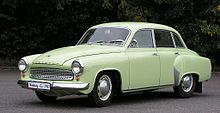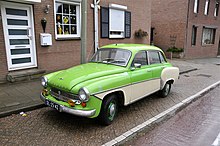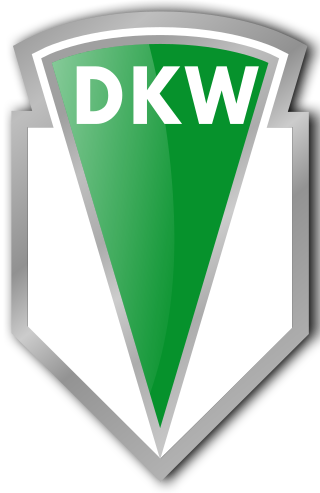
DKW was a German car- and motorcycle-marque. DKW was one of the four companies that formed Auto Union in 1932 and thus became an ancestor of the modern-day Audi company.

The Dixi was the first car made by BMW.

Gothaer Waggonfabrik was a German manufacturer of rolling stock established in the late nineteenth century at Gotha. During the two world wars, the company expanded into aircraft building.
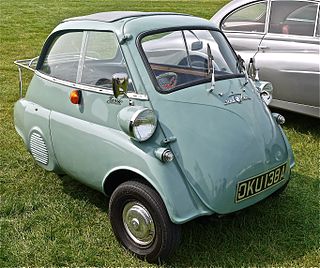
The Isetta is an Italian-designed microcar built under license in a number of different countries, including Argentina, Spain, Belgium, France, Brazil, Germany, and the United Kingdom. Because of its egg shape and bubble-like windows, it became known as a bubble car, a name also given to other similar vehicles.
The BMW 3/15 was BMW's first car, produced in its first version as a "Dixi" between 1927 and 1929 and then, following BMW's acquisition of the Dixi business in October 1928, in three subsequent versions as BMWs from July 1929 till March 1932, when BMW gave up the licence under which the Austin designed cars were produced.
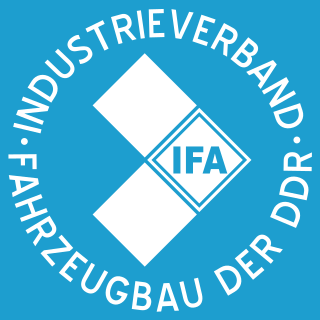
Industrieverband Fahrzeugbau, usually abbreviated as IFA, was a conglomerate and a union of companies for vehicle construction in the former East Germany.

Melkus was an East German marque of single seat racing cars and sport cars founded by the race driver Heinz Melkus in Dresden in East Germany.
The Automobilwerk Eisenach (AWE) was an automobile manufacturer in Eisenach, Germany.
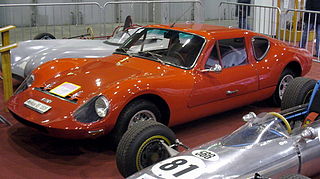
Melkus RS 1000 is a sports car produced by Melkus. It is powered by a tuned, mid-mounted 3-cylinder 2-stroke 992 cm3 engine, similar to the one in the Wartburg 353, and features gull-wing doors. 101 cars were made between 1969 and 1979 in the Dresden factory.

The BMW 303 was a small family saloon produced by BMW in 1933 and 1934. It was the first BMW motor car with a six-cylinder engine and the first BMW motor car with the "kidney grille" associated with the brand. The platform developed for the 303 was used for several other BMW cars, including the BMW 309, a four-cylinder version of the 303, the BMW 315, a 1.5-litre version of the 303 which replaced it in 1934 and was built until 1937, the BMW 319, a 1.9-litre version of the 303 produced alongside the 315 from 1935 to 1937, and the BMW 329, a development of the 319 with styling based on the newer, larger BMW 326, that briefly replaced the 319 in 1937.

The Wartburg 353, known in some export markets as the Wartburg Knight, is a medium-sized family car, produced by the East German car manufacturer AWE for their Wartburg brand. It was the successor of the Wartburg 311, and was itself succeeded by the Wartburg 1.3.

The official founding date of the German motor vehicle manufacturer BMW is 7 March 1916, when an aircraft producer called Bayerische Flugzeugwerke was established. This company was renamed to Bayerische Motoren Werke (BMW) in 1922. However, the BMW name dates back to 1917, when Rapp Motorenwerke changed its name to Bayerische Motoren Werke. BMW's first product was a straight-six aircraft engine called the BMW IIIa. Following the end of World War I, BMW remained in business by producing motorcycle engines, farm equipment, household items and railway brakes.
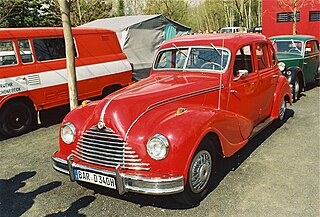
The BMW 340, subsequently rebadged as the EMW 340, was a large six-cylinder four-door passenger saloon produced at Eisenach initially in the name of BMW. Five-door 340 station wagons were also manufactured. It was described in 1948 as the first new car model produced in Germany after the war: despite new body panels, under the skin it was a modified version of the BMW 326 with which it shared its engine and wheelbase, and which had originally been commercialised in 1936. The 326 had nevertheless been an innovative and well regarded product and the 340, which incorporated several improvements, was seen as a desirable car well into the 1950s. Early years were dogged by disputes centred on ownership of the plant where it was assembled and its manufacturers’ rights to use the BMW name. The cars later appeared badged as EMW 340s, and it was under this name that 340s continued to be sold until at least 1953.

The IFA F9, subsequently rebadged as the EMW 309, is a compact saloon manufactured under the auspices of the Russian and East German states between 1949 or 1950 and 1956. It was initially built at Zwickau at the plant previously owned by Auto Union. In 1953 production was transferred to the EMW, former BMW manufacturing plant at Eisenach under the name EMW 309 until 1956 where its underpinnings subsequently found their way into the Wartburg 311.

The Wartburg 311 is a car produced by East German car manufacturer VEB Automobilwerk Eisenach from 1956 to 1965. The 311 model was manufactured in a number of variations, including pickup, sedan, limousine, coupé, and as a two-seat roadster. The two-stroke engine was enlarged to 992 cc in 1962. An interim model, called the Wartburg 312 and featuring the chassis developed for the succeeding 353, was built from 1965 until 1967.

The Institec Justicialista was a line of cars produced by the government of Argentina via IAME from 1954 to 1955 as an attempt to develop a native Argentine automotive industry. It used a front-engine, front-wheel-drive layout with a two-stroke two-cylinder engine derived from a German DKW design and a conventional metal body. Due to the insistence of General Juan Domingo Perón a sports car prototype was made, a two-seat version was showcase as roadster in the Paris Motor Show. The prototype was repurposed Porsche with a fiberglass body powered by a 1.5-liter air-cooled Porsche flat-four engine and a Porsche four-speed gearbox driving the front wheels.

Opel Eisenach GmbH is a German manufacturing company based at Eisenach in Thuringia, Germany and a subsidiary of Opel. It currently produces the Opel Grandland.

The Wartburg 1.3 is a car which was produced by Automobilwerk Eisenach between October 1988 and April 1991. The car was an updated version of the Wartburg 353, with a 1.3-litre, four-stroke, four-cylinder engine as also used in the second generation Volkswagen Polo, instead of the original 1-litre, two-stroke, three-cylinder unit found in the 353.

Automobile Welt Eisenach is a car museum located in the old East German town of Eisenach adjacent to the banks of the Hörsel river. It is situated on the old Automobilwerk Eisenach factory site, one of the world's oldest, and opened as a museum in 2005 utilising building O2 from 1935.

RGW-Auto was a joint project for the construction of passenger cars in the former East Germany and Czechoslovakia. Both countries were members of Comecon. The aging Trabant 601, Wartburg 353, Škoda 100 and Dacia 1300 were to be replaced by vehicles with a modern design. The manufacturers involved were Automobilwerk Eisenach (Wartburg), Sachsenring Automobilwerke Zwickau (Trabant), AZNP Mladá Boleslav (Škoda) and Uzina de Autoturisme Pitești (Dacia). Mass production of the ambitious project was to begin in 1978, but it never happened.




